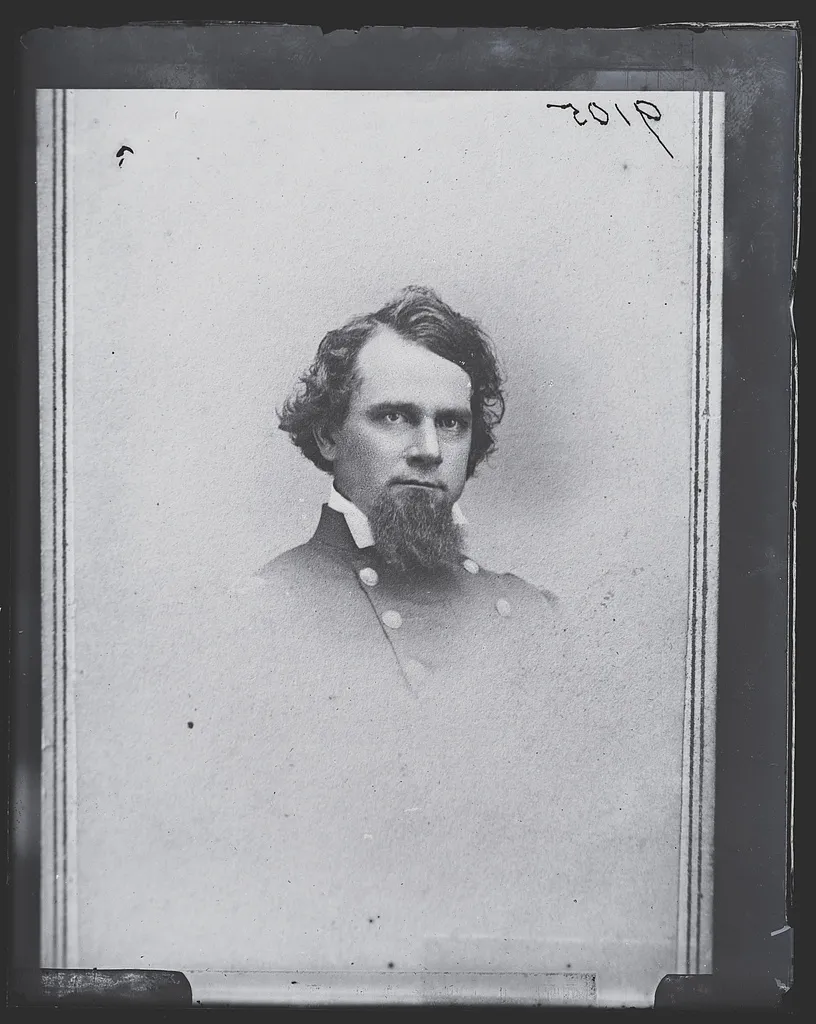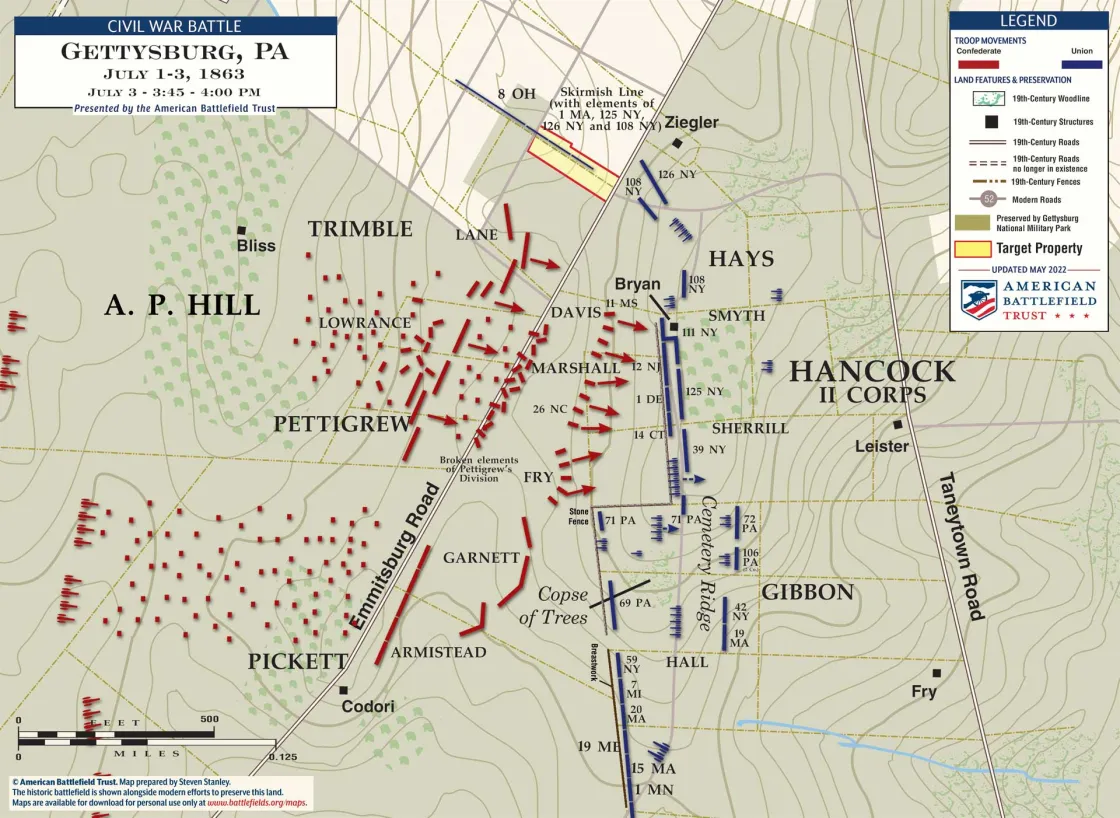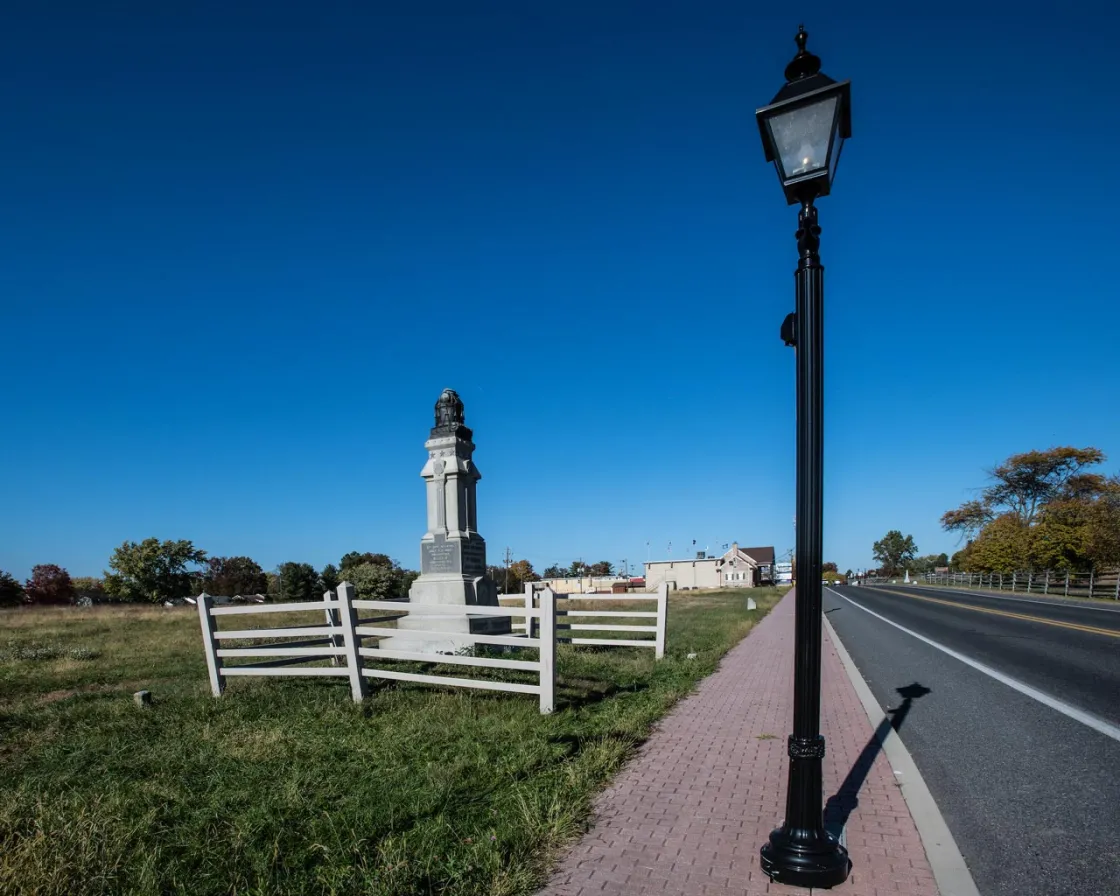A Picket Line against Pickett's Charge

Thousands of Union soldiers witnessed the Confederate attack which is now popularly called “Pickett’s Charge.” However, one regiment from Col. Samuel Sprigg Carroll’s Brigade had a unique view of their enemy’s march across open fields toward the copse of trees and the fateful stone-walled angle. This unit—the 8th Ohio—poised in advance of the Union lines at Ziegler’s Grove, on the west side of the Emmitsburg Road and directly on the left flank of Pettigrew’s charging Confederates. According to one Ohioan, “We found ourselves a single regiment of less than three hundred men, two hundred yards in front of the main Federal position. Seemingly a forlorn position for us, but, as it turned out, destined to play an unexpectedly vital part in the defense of the salient angle...”
Experience on previous battlefields shaped how the soldiers of the 8th Ohio viewed the Confederate attack. Their regiment formed in June 1861 and spent the early months of enlistment in western Virginia. They fought “Stonewall” Jackson in the Romney Campaign in January 1862 and in the Valley Campaign later that year. The 8th Ohio charged the Sunken Roads at both Antietam and Fredericksburg, suffering devastating casualties. In 1863, the Ohioans fought at Chancellorsville, and marched north as the Union Army countered the Confederate invasion into Pennsylvania. At Gettysburg, the unit arrived as part of the First Brigade, Third Division, Second Corps and brought 209 commanded by Lieutenant Colonel Franklin Sawyer to the field.

On the afternoon of July 2, the 8th Ohio “received an order...to move...forward to the picket line in front of our position and on the left of the pickets of the Eleventh Corps. This was at once executed, the regiment moving forward gallantly under a smart fire of the enemy’s pickets, sharpshooters, and shell...” Lieutenant Colonel Sawyer continued in his official report that, in the following hours, his regiment suffered 42 casualties in picket line skirmishing. Sawyer's men held their advanced position “during the twenty-four hours without any relief.” Throughout the late afternoon on July 2 and in the early morning hours of July 3, the 8th Ohio skirmished with advanced Confederates, sometimes advancing, then falling back to a minimally protected position. They watched the burning of the Bliss Farm, approximately 150 yards to their front and advanced briefly to support the New York troops at that location.
Corporal Thomas Galwey described a temporary truce which occurred “about the middle of the forenoon” on July 3 in front of the 8th Ohio’s position. It started when numerous Confederate skirmishers shouted, “Don’t fire, Yanks!” Then “a man with his gun slung across his shoulder came out from the tree. Several of our fellows aimed at him but the others checked them, to see what would follow. The man had a canteen in his hand and, when he had come about half-way to us, we saw him (God bless him) kneel down and give a drink to one of our wounded who lay there beyond us. Of course we cheered the Reb, and someone shouted, ‘Bully for you! Johnny!’ Whilst this was going on, we had all risen to our feet. The enemy, too, having ceased fire, were also standing. As soon as the sharpshooter had finished his generous work, he turned around and went back to the tree, and then at the top of his voice shouted, ‘Down Yanks, we’re going to fire.’ And down we lay again.”
The violence of war quickly overshadowed that moment of humanity, particularly as the afternoon cannonade erupted prior to the main Confederate assault. According to 8th Ohio regimental historian, “The missiles of both armies passed over our heads.” The regiment kept a skirmish line advanced in the field, but most of the men sheltered in a ditch near the Emmitsburg Road. Thomas Galwey watched the shells arching overhead, but after a while, he fell asleep despite the thunderous roar. The pain of a spent shell fragment striking his foot woke him, followed by another injury to his thigh. Galwey kept his place with the rest of his regiment, suspecting that a large-scale infantry attack would follow the artillery barrage.
Observing a change in the skirmishers near the Bliss farm, the 8th Ohio readied to repulse an attack. A staff officer ordered the regiment to advance. Galwey later remembered: “For a minute we saw nothing but the smoke of our skirmishers in front. Then came a distant murmur from the front, followed by a renewal of our artillery fire, which had slackened for a few minutes. All at once the murmur increased into a prolonged yell, and we saw the enemy with colors flying advancing in columns in mass.”

The moment impressed Galwey even as he rushed to repulse the Confederate advance. “I had often read of battles and of charges; had been in not a few myself; but until this moment I had not gazed upon so grand a sight as was presented by that beautiful mass of gray, with its small, square colors, as it came on in serried array, cheering their peculiar cheer, right towards the crest of the hill which we and our batteries were to defend. We went forward to the fence line at a run; and now against us moved a large force of the enemy who were formed to the north of the column in mass.”
Lieutenant Colonel Sawyer reported: “I advanced my reserve to the picket front, and as the rebel line came within about 100 yards, we poured in a well-directed fire, which broke the rebel line.” However, more Confederates advanced. Pettigrew and Pender’s divisions swept toward the advanced Union regiment.
“A few seconds, and a cheer rises to the west of us. Now Pender’s line, with colors flying, issues from the trees that cover the crest of the low ridge to our front, and comes right towards us,” Galwey recalled. Quickly changing fronts, the 8th Ohio turned on the flank of the next wave of Confederate lines. This position gave the unit a unique perspective on the Confederates’ final rush toward the Angle. Despite the flank fire from the Eighth, many of the Confederates still “brave and cheering...ascend[ed] the stonewall.” There, a Union counterattack shoved back the North Carolinians, forcing them to retreat across the 8th Ohio’s position. The Confederate “mass gave way, some fleeing to the front, some to the rear, and some through our lines, until the whole plain was covered with unarmed rebels, waving coats, hats, and handkerchiefs in token of a wish to surrender,” Sawyer later reported.

As Pettigrew’s division fell back from the stone wall on Cemetery Ridge, the Ohioans sprang upon them. According to the regimental history, “the Eighth advanced and cut off three regiments, or remnants of regiments, as they passed us.” Lieutenant Colonel Sawyer reported the capture of approximately 200 prisoners and 3 Confederate flags including the banners of the 34th North Carolina and the 38th Virginia. Two members of the regiment — Corporal John G. Miller and Private James Richmond — later received the Medal of Honor for capturing these flags.
In his report written just two days after the battle, Sawyer recorded 101 men killed, wounded or missing from the 8th Ohio, nearly half of the regiment. The Ohioans buried their dead, marking the graves and surrounded them with a rail fence.
The 8th Ohio Regiment had been ordered to an advanced position which gave them a unique perspective and role in the repulse of Pickett’s Charge. Though a small unit, they hemmed in the Confederates, propelling the attack toward the Angle by their flanking fire. The Ohioans held their lines and charged forward when presented with an advantage.
If the American Battlefield Trust’s preservation efforts are successful, the flank positions of the 8th Ohio and their view of the fields of the Pickett’s Charge will be more visible. The perspective will add to the understanding of this small regiment’s role in the battle and the scene that they witnessed on the afternoon of July 3, 1863. It will be possible to look toward the Angle, seeing the view of the 8th Ohio when they saw Confederates charge “the last slope and now have nothing between them and the crest of the heights but the blue-clad men who, at one part of the line, are behind a stone wall.” The opportunity to better explore Pickett’s Charge from a flank position and stand alongside some of the historic footprints of the 8th Ohio Regiment will offer a new perspective and view on one of the most famous hours in Gettysburg’s history.

Further Reading:
Thomas Francis Galwey, The Valiant Hours: Narrative Of “Captain Brevet,” An Irish-American In The Army Of The Potomac
James A. Hessler and Wayne E. Motts, Pickett’s Charge at Gettysburg (El Dorado Hills, Savas Beatie, 2015).
Franklin Sawyer, A Military History of the 8th Ohio Vol. Infantry, published in 1881.
Official Records of the War of the Rebellion, Volume 27, Part 1, Reports.
We're on the verge of a moment that will define the future of battlefield preservation. With your help, we can save over 1,000 acres of critical Civil...
Related Battles
23,049
28,063





